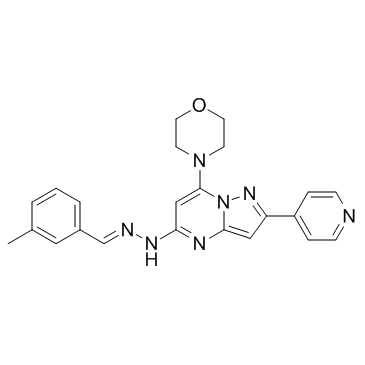APY0201 |
| Catalog No.GC31661 |
APY0201 est un puissant inhibiteur de PIKfyve, qui inhibe la conversion de PtdIns3P en PtdIns(3,5)P2 en présence de [33P]ATP avec une IC50 de 5,2 nM.
Products are for research use only. Not for human use. We do not sell to patients.

Cas No.: 1232221-74-7
Sample solution is provided at 25 µL, 10mM.
APY0201 is a potent PIKfyve inhibitor, which inhibits the conversion of PtdIns3P to PtdIns(3,5)P2 in the presence of in the presence of [33P]ATP with an IC50 of 5.2 nM. APY0201 also inhibits IL-12/IL-23 production.
APY0201 works differently from anti-IL-12/23 antibodies and acts by inhibiting production of these proinflammatory cytokines with characteristic selectivity over other cytokines, including tumor necrosis factor-alpha (TNF-α). In stimulated thioglycollate-induced mouse peritoneal exudate cells (TG-PEC), APY0201 strongly inhibits IL-12p70 and IL-12p40 production, with IC50s of 8.4 and 16 nM, respectively. APY0201 also inhibits IL-12p40 at 99 nM in human PBMC. APY0201 shows significant selectivity for the production of IL-12p70 and IL-12p40 over TNF-α, and this selectivity is maintained across species[1].
Oral APY0201 at a 30 mg/kg dose shows significant reduction of IL-12p70 production (78% inhibition relative to that of the vehicle control), which implys that the inhibitory potential of APY0201 against IL-12 is confirmed in the animal experiment[1].
[1]. Hayakawa N, et al. Structure-activity relationship study, target identification, and pharmacological characterization of a small molecular IL-12/23 inhibitor, APY0201. Bioorg Med Chem. 2014 Jun 1;22(11):3021-9.
Average Rating: 5 (Based on Reviews and 17 reference(s) in Google Scholar.)
GLPBIO products are for RESEARCH USE ONLY. Please make sure your review or question is research based.
Required fields are marked with *




















